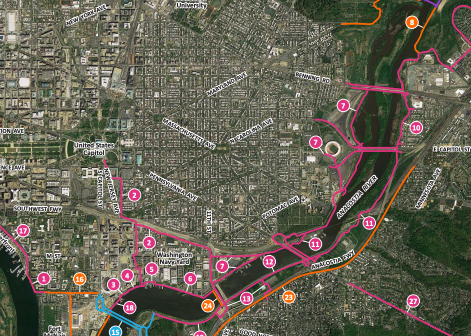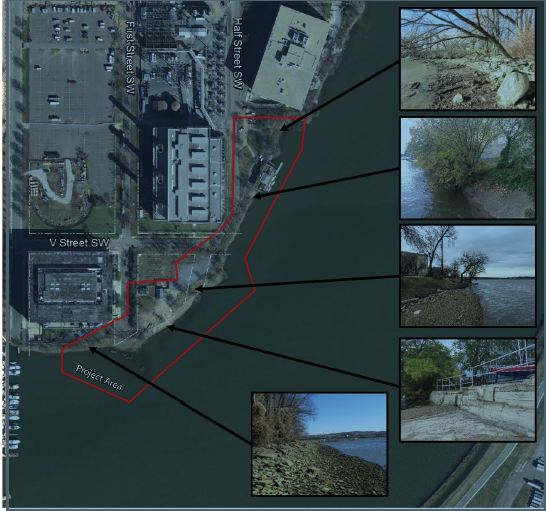Check out plans for the Buzzard Point Park section of the Anacostia Riverwalk Trail

Bridge over the tracks on the Anacostia Riverwalk Trail by Joe Flood licensed under Creative Commons.
The partially-finished Anacostia Riverwalk Trail runs along both sides of the river, giving people walking, scooting, skating, and bicycling a safe path to travel along the waterfront. To date, 12 of the total 20 miles of the trail project have been completed, and details for a new section that’s part of a park project in Buzzard Point came into view at a recent community meeting.
In late July, the National Parks Service (NPS) hosted an open house on the Environmental Assessment for the Buzzard Point Park Improvement Project. The project will include about 1,000 feet of Anacostia Riverwalk Trail, and will fill in a gap between two sections currently under development as part of the River Point and 1900 Half Street building conversion projects.
When completed, the Anacostia Riverwalk Trail will provide access to the Fish Market, Nationals Park, Historic Anacostia, RFK Stadium, the National Arboretum, and more. Click for a full version of the map. 
The trail is one of the driving forces for the park improvement, so it was the focus of much of the presentation even if it wasn’t much of the discussion (a lot of wildlife lovers are interested in this project for other reasons).
The purpose of the Buzzard Point Park Improvements project is to transform the Park into an accessible community waterfront amenity that continues the Anacostia Riverwalk Trail (ART).
At the meeting, NPS presented its preferred alternative: Transforming the park into a linear waterfront facility that’s integrated into the neighborhood. Of the two options for this alternative, it settled on Option 2, which mostly deals with how the park connects to the waterfront (with a stone revetment or, in the preferred option, a boardwalk). The trail portion is basically the same.
For both Options, the ART would be extended through the Park as a multi-use trail of varying widths (between 10-16 feet) to allow for access to recreational features along the trail without inhibiting circulation. The multi-use trail would be higher in elevation than the passive walking trail and would continue through the central portion of the Park. The trail would then tie into the terminus of the existing ART at the southern end of the Park.
Buzzard Point Park Improvement Project area. Image by NPS.
The trail would start at the Half Street property line, where it would connect to that section of the trail, and pass by a small parking lot and Matthew Henson building before going through the pinchpoint. South of V Street, it would pass through some activity areas with access to the water and then connect to the River Point Section of the trail. On the other side of River Point, it connects to the protected bicycle lane on 2nd Street.
Rendering of Alternative B, Option 2. Image by NPS.
Earlier in the process, NPS had considered a trail structure over the water, but that was eliminated because of public concern, worry about trash and safety, and possible impact on fish. At the meeting, some asked if perhaps a small one could be used at the pinch point, where V meets Half Street.
I suggested that DC or NPS try to buy the old right-of-way on Water Street when PEPCO disposes of the power plant there. The road can be shifted over to there and the park can be expanded a bit where it’s needed. For now, the plan is to separate the trail and road with a wall or fence and build the boardwalk next to it, and also narrow the trail to 10 feet (see image below).
A lot of the discussion was about bird habitat and fish, and it was all very pleasant—no one was fearing for the children or complaining about parking, and I heard no opposition to the trail at all. Hopefully this step will go smoothly, so the District Department of Transportation can turn to the section connecting T Street to the South Capital Street Bridge.

